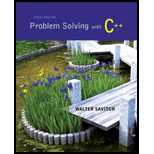
Concept explainers
You have just purchased a stereo system that cost $1,000 on the following credit plan: no down payment, an interest rate of 18% per year (and hence 1.5% per month), and monthly payments of $50. The monthly payment of $50 is used to pay the interest and whatever is left is used to pay part of the remaining debt. Hence, the first month you pay 1.5% of $1,000 in interest. That is $15 in interest. So, the remaining $35 is deducted from your debt, which leaves you with a debt of $965.00. The next month you pay interest of 1.5% of $965.00, which is $14.48. Hence, you can deduct $35.52 (which is $50 – $14.48) from the amount you owe. Write a
Want to see the full answer?
Check out a sample textbook solution
Chapter 2 Solutions
Problem Solving with C++ plus MyProgrammingLab with Pearson eText-- Access Card Package (9th Edition)
Additional Engineering Textbook Solutions
Starting Out With Visual Basic (8th Edition)
SURVEY OF OPERATING SYSTEMS
Starting Out with Java: From Control Structures through Data Structures (4th Edition) (What's New in Computer Science)
Starting Out with C++ from Control Structures to Objects (9th Edition)
Elementary Surveying: An Introduction To Geomatics (15th Edition)
Java: An Introduction to Problem Solving and Programming (8th Edition)
- Node.js, Express, and Nunjucks Templates?arrow_forwardCIT244 Program Project 3 Assignment As with any assigned program, do not wait until the last minute to start. Start early in the week the program is due so you can ask questions if you get stuck Node.js and Express and Nunjucks Templates We have gotten to the good stuff. There is a program similar to this assignment given as the last example in the lecture notes for the week that discusses node static files. This program will take more time that previous assignments. There are several examples you should study first, particularly the pizza order example program available in the examples programs folder for the week discussing static files. You should study and run the pizza order program before trying this program. The pseudo-company is called Sun or Fun, which offers cheap flights from Louisville to either Miami or Vegas. Here's a video of how it should work. NOTE: You will hear or see references to Handlebars in this video. We used to use Handlebars, but it will be Nunjucks that we…arrow_forwardhow to write the expression for the outputarrow_forward
- Discussion 1. Comment on your results. 2. Compare between the practical and theoretical results. 3. Find VB, Vc on the figure below: 3V V₁₁ R₁ B IR, R, IR, R www ΙΚΩ www www I 1.5KQ 18₁ 82002 R₁ 3.3KQ R₂ 2.2KQ E Darrow_forwardAgile1. a. Describe it and how it differs from other SDLC approachesb. List and describe the two primary terms for the agile processc. What are the three activities in the Construction phasearrow_forwardhow are youarrow_forward
- need help with thi Next, you are going to combine everything you've learned about HTML and CSS to make a static site portfolio piece. The page should first introduce yourself. The content is up to you, but should include a variety of HTML elements, not just text. This should be followed by an online (HTML-ified) version of your CV (Resume). The following is a minimum list of requirements you should have across all your content: Both pages should start with a CSS reset (imported into your CSS, not included in your HTML) Semantic use of HTML5 sectioning elements for page structure A variety other semantic HTML elements Meaningful use of Grid, Flexbox and the Box Model as appropriate for different layout components A table An image Good use of CSS Custom Properties (variables) Non-trivial use of CSS animation Use of pseudeo elements An accessible colour palette Use of media queries The focus of this course is development, not design. However, being able to replicate a provided design…arrow_forwardUsing the notationarrow_forwardyou can select multipy optionsarrow_forwardarrow_back_iosSEE MORE QUESTIONSarrow_forward_ios
 C++ Programming: From Problem Analysis to Program...Computer ScienceISBN:9781337102087Author:D. S. MalikPublisher:Cengage Learning
C++ Programming: From Problem Analysis to Program...Computer ScienceISBN:9781337102087Author:D. S. MalikPublisher:Cengage Learning C++ for Engineers and ScientistsComputer ScienceISBN:9781133187844Author:Bronson, Gary J.Publisher:Course Technology PtrNp Ms Office 365/Excel 2016 I NtermedComputer ScienceISBN:9781337508841Author:CareyPublisher:Cengage
C++ for Engineers and ScientistsComputer ScienceISBN:9781133187844Author:Bronson, Gary J.Publisher:Course Technology PtrNp Ms Office 365/Excel 2016 I NtermedComputer ScienceISBN:9781337508841Author:CareyPublisher:Cengage Operations Research : Applications and AlgorithmsComputer ScienceISBN:9780534380588Author:Wayne L. WinstonPublisher:Brooks Cole
Operations Research : Applications and AlgorithmsComputer ScienceISBN:9780534380588Author:Wayne L. WinstonPublisher:Brooks Cole EBK JAVA PROGRAMMINGComputer ScienceISBN:9781337671385Author:FARRELLPublisher:CENGAGE LEARNING - CONSIGNMENTProgramming Logic & Design ComprehensiveComputer ScienceISBN:9781337669405Author:FARRELLPublisher:Cengage
EBK JAVA PROGRAMMINGComputer ScienceISBN:9781337671385Author:FARRELLPublisher:CENGAGE LEARNING - CONSIGNMENTProgramming Logic & Design ComprehensiveComputer ScienceISBN:9781337669405Author:FARRELLPublisher:Cengage





